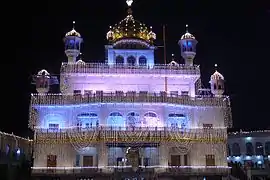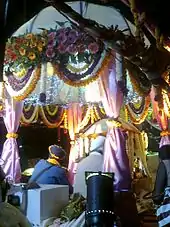Guru Nanak Gurpurab
Guru Nanak Dev Ji Gurpurab, also known as Guru Nanak's Prakash Utsav and Guru Nanak Dev Ji Jayanti, celebrates the birth of the first Sikh guru, Guru Nanak.[3] One of the most celebrated Sikh gurus and the founder of Sikhism, Guru Nanak Dev is highly revered by the Sikh community. [4] This is one of the most sacred festivals in Sikhism, or Sikhi.[5]
| Guru Nanak Dev Ji Gurpurab | |
|---|---|
 | |
| Official name | Guru Nanak Jayanti |
| Also called | Parkash Guru Nanak Dev Ji |
| Observed by | Sikhs, Nanakpanthis |
| Significance | Guru Nanak's birthday |
| Observances | festival |
| Date | Kartik Pooranmashi |
| 2020 date | 30 November[1] |
| 2021 date | 19 November[2] |
The festivities in the Sikh religion revolve around the anniversaries of the 10 Sikh Gurus. These Gurus were responsible for shaping the beliefs of the Sikhs . Their birthdays, known as Gurpurab, are occasions for celebration and prayer among the Sikhs.[6]
Background
Guru Nanak, the founder of Sikhism, was born on Puranmashi of Kattak in 1469, according to the Bikrami calendar[7] in Rai-Bhoi-di Talwandi in the present Shekhupura District of Pakistan, now Nankana Sahib.[8] It is a Gazetted holiday in India.[9]
According to the controversial Bhai Bala Janamsakhi, it claims Guru Nanak was born on the Full Moon (Pooranmashi) of the Indian Lunar Month Kartik.[10] The Sikhs have been celebrating Guru Nanak's Gurpurab around November for this reason and has it been ingrained in Sikh Traditions.[3][11]
However, some scholars and organizations believe the Birthday should be celebrated on Vaisakhi, which falls on 14 April according to the original[12] Nanakshahi Calendar passed by Sri Akal Takht in 2003. However, many people and organizations would like to keep the traditional date by celebrating on the Full Moon Day (Pooranmashi or Purnima) of the Lunar Month Kartik. The original Nanakshahi Calendar follows the tradition and celebrates it on Kartik Purnima due to demands by various Sikh Saints.[13]
The festival

The celebration is generally similar for all Sikhs; only the hymns are different. The celebrations usually commence with Prabhat Pheris. Prabhat Pheris are early morning processions that begin at the Gurudwaras and proceed around the localities singing hymns. Generally, two days before the birthday, Akhand Path (a forty-eight-hour non-stop reading of the Guru Granth Sahib, the holy book of the Sikhs) is held in the Gurdwaras.[14]
The day prior to the birthday, a procession, referred to as Nagarkirtan,[15] is organised. This procession is led by the Panj Pyaras (Five Beloved Ones).[16][17] They head the procession carrying the Sikh flag, known as the Nishan Sahib and the Palki (Palanquin) of Guru Granth Sahib.[18] They are followed by teams of singers singing hymns[17] and devotees sing the chorus. There are brass bands playing different tunes and 'Gatka' teams display their swordsmanship through various martial arts and as mock battles using traditional weapons.[16][15] The procession pours into the streets of the town. The passage is covered with banners and gates are decorated flags and flowers, for this special occasion.[16][15] The leaders spreading the message of Guru Nanak.[16]

On the day of the Gurpurab, the celebrations commence/begin early in the morning at about 4 to 5 a.m.[15][16] This time of the day is referred to as Amrit Vela. The day begins with the singing of Asaa-Ki-Vaar (morning hymns).[15][16] This is followed by any combination of Katha[15] (exposition of the scripture) and Kirtan (hymns from the Sikh scriptures), in the praise of the Guru.[16] Following that is the Langar, a special community lunch, which is arranged at the Gurudwaras by volunteers. The idea behind the free communal lunch is that everyone, irrespective of gender, caste, class or creed,[19] should be offered food in the spirit of seva (service) and bhakti (devotion).
Night prayer sessions are also held in some Gurudwaras, which begin around sunset when Rehras (evening prayer) is recited, followed by Kirtan till late at night.[16] The congregation starts singing Gurbani at about 1:20 a.m., which is the actual time of birth of Guru Nanak. The celebrations culminate at around 2 a.m.[16]
Guru Nanak Gurpurab is celebrated by the Sikh community all over the world and is one of the most important festivals in the Sikh calendar. The celebrations are especially colorful in Punjab, Haryana, and Chandigarh and many more locations like in parts of Pakistan and England. Even some Sindhis celebrate this festival.[20]
Celebrating the auspicious day, the Punjab government has announced that it will install chairs dedicated to the great saint in 11 universities. The announcement was made on 11 November 2019.[21]
Public Holiday
Guru Nanak Jayanti is celebrated as public holiday in following places:
| Country | States/Provinces |
|---|---|
| India [22] | Punjab, Haryana, Rajasthan, Delhi, Uttar Pradesh, Madhya Pradesh, Gujarat, Maharashtra, Jharkhand, West Bengal |
References
- "Movable Holidays". nanakshahi.net. Set year to 2020, and click "Get Dates". Archived from the original on 30 August 2019. Retrieved 22 November 2018.
- "Movable Holidays". nanakshahi.net. Set year to 2021, and click "Get Dates". Archived from the original on 30 August 2019. Retrieved 22 November 2018.
- Singh Purewal, Pal. "Birth Date of Guru Nanak Sahib" (PDF). Purewal's Page. Pal Singh Purewal. Archived (PDF) from the original on 22 February 2015. Retrieved 16 June 2017.
- "Happy Gurpurab 2020: Guru Nanak Jayanti Wishes Images, Status, Quotes, Wallpapers, Messages, Photos". The Indian Express. 30 November 2020. Retrieved 30 November 2020.
- "Guru Nanak Jayanti 2019: History, significance and traditions". Hindustan Times. Archived from the original on 14 December 2019. Retrieved 5 May 2020.
- "Guru Nanak Dev Ji and Sikh 10 Gurus". Sikh legendaries. 3 May 2020. Archived from the original on 28 November 2020. Retrieved 5 May 2020.
- Singh Purewal, Pal. "Vaisakhi Dates Range According To Indian Ephemeris By Swamikannu Pillai – i.e. English Date on 1 Vaisakh Bikrami" (PDF). Pal Singh Purewal. Archived (PDF) from the original on 4 October 2018. Retrieved 25 June 2017.
- "Guru Nanak Dev ji (1469–1539)". Archived from the original on 30 August 2007. Retrieved 26 December 2011.
- "Guru Nanak Jayanti in India". www.timeanddate.com. Retrieved 28 November 2020.
- Singh Mehboob, Harinder. As the Sun of Suns Rose: The Darkness of the Creeds Was Dispelled.
- Singh Purewal, Pal. "Movable Dates of Gurpurbs" (PDF). www.purewal.biz. www.purewal.biz. Archived (PDF) from the original on 22 December 2018. Retrieved 4 November 2017.
- "Mool Nanakshai Calendar (MNC) Implementation Conference". SikhNet. Archived from the original on 7 February 2018. Retrieved 28 November 2020.
- "Sikhism Religion of the Sikh People". www.sikhs.org. sikhs.org. Archived from the original on 4 December 2018. Retrieved 22 November 2018.
- Rumi, Faryal (24 November 2020). "'Prabhat pheri' to set off from Patna Sahib gurdwara today". The Times of India. Archived from the original on 25 November 2020. Retrieved 24 November 2020.
- "GURPURBS". Archived from the original on 1 June 2009.
- "What's your point?". Sikhpoint.com. Archived from the original on 22 September 2019. Retrieved 12 November 2019.
- "Guru Nanak". Archived from the original on 8 November 2011. Retrieved 26 December 2011.
- "Gurpurab 2020 date: All you need to know about Guru Nanak Jayanti". The Times of India. 27 November 2020. Retrieved 30 November 2020.
- "Guru Purab". Archived from the original on 24 December 2011. Retrieved 26 December 2011.
- Satpathy, Kriti Saraswat (14 November 2016). "Guru Nanak Jayanti: Why and how Gurpurab is celebrated in India". India News, Breaking News, Entertainment News | India.com. Archived from the original on 28 November 2020. Retrieved 25 November 2020.
- "Punjab government to install chair dedicated to Guru Nanak Dev in 11 universities". Hindustan Times. 11 November 2019. Archived from the original on 12 November 2019. Retrieved 12 November 2019.
- "Guru Nanak Jayanti 2020, 2021 and 2022". PublicHolidays.in. Archived from the original on 30 September 2020. Retrieved 28 April 2020.